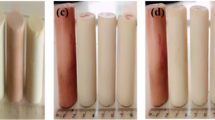Abstract
This work studied ARP-lime mixtures to understand the mechanisms of chloride binding capacity by alumina-rich pozzolan (ARP) in cementitious materials. Three ARPs including metakaolin (MK), fly ash (FA) and blast-furnace slag (SG) were evaluated. The chloride binding capacity, hydration products, chemically bound water, residual calcium hydroxide and alkali in pore solution were investigated. Results show that chloride binding capacity of ARP-lime mixture significantly depends on CaO to Al2O3 (C/A) ratio of the mixture. Friedel’s salt is formed at the expense of stratlingite and carboaluminate, accompanied with obvious improvement of alkali content in pore solution and consumption of calcium hydroxide. The additional alkali can improve the reaction of ARP and result in more bound water. Moreover, MK shows overwhelmingly higher chloride binding capacity than FA and SG.








Similar content being viewed by others
References
Alonsoa C, Andrade C, Castellote M, Castro P (2000) Chloride threshold values to depassivate reinforcing bars embedded in a standardized OPC mortar. Cem Concr Res 30:1047–1055
Figueira RB, Sadovski A, Melo AP, Pereira EV (2017) Chloride threshold value to initiate reinforcement corrosion in simulated concrete pore solutions: the influence of surface finishing and pH. Constr Build Mater 141:183–200
Manera M, Vennesland O, Bertolini L (2008) Chloride threshold for rebar corrosion in concrete with addition of silica fume. Corros Sci 50(2):554–560
Glass GK, Buenfeld NR (1997) The presentation of the chloride threshold level for corrosion of steel in concrete. Corros Sci 39(5):1001–1013
Song HW, Lee CH, Jung MS, Ann KY (2008) Development of chloride binding capacity in cement pastes and influence of the pH of hydration products. Can J Civ Eng 35(12):1427–1434
Florea MVA, Brouwers HJH (2012) Chloride binding related to hydration products part I: ordinary Portland cement. Cem Concr Res 42:282–290
Elakneswaran Y, Nawa T, Kurumisawa K (2009) Electrokinetic potential of hydrated cement in relation to adsorption of chlorides. Cem Concr Res 39(4):340–344
Qiao C, Suraneni P, Ying TN, Choudhary A, Weiss J (2018) Chloride binding of cement pastes with fly ash exposed to CaCl2 solutions at 5 and 23°C. Cem Concr Compos 97:43–53
Suraneni P, Azad VJ, Isgor OB, Weiss WJ (2016) Calcium oxychloride formation in pastes containing supplementary cementitious materials: thoughts on the role of cement and supplementary cementitious materials reactivity. RILEM Tech Lett 1:24–32
Zibara H, Hooton RD, Thomas MDA, Stanish K (2008) Influence of the C/S and C/A ratios of hydration products on the chloride ion binding capacity of lime-SF and lime-MK mixtures. Cem Concr Res 38(3):422–426
Wang Y, Shui Z, Gao X, Huang Y, Yu R, Ling G (2019) Chloride binding behaviors of metakaolin-lime hydrated blends: influence of gypsum and atmospheric carbonation. Constr Build Mater 201:380–390
Jensen OM, Korzen MSH, Jakobsen HJ, Skibsted J (2000) Influence of cement constitution and temperature on chloride binding in cement paste. Adv Cem Res 12(2):57–64
Thomas MDA, Hooton RD, Scott A, Zibara H (2012) The effect of supplementary cementitious materials on chloride binding in hardened cement paste. Cem Concr Res 42(1):1–7
Wang Y, Shui Z, Gao X, Yu R, Huang Y, Cheng S (2019) Understanding the chloride binding and diffusion behaviors of marine concrete based on Portland limestone cement-alumina enriched pozzolans. Constr Build Mater 198:207–217
Wang Y, Shui Z, Huang Y, Sun T, Duan P (2018) Properties of coral waste-based mortar incorporating metakaolin: part II. Chloride migration and binding behaviors. Constr Build Mater 174:433–442
Ishida T, Miyahara S, Maruya T (2008) Chloride binding capacity of mortars made with various Portland cements and mineral admixtures. J Adv Concr Technol 6(2):287–301
Ogirigbo OR, Black L (2017) Chloride binding and diffusion in slag blends: Influence of slag composition and temperature. Constr Build Mater 149:816–825
Yi C, Ma H, Zhu H, Li W, Xin M, Liu Y, Guo Y (2018) Study on chloride binding capability of coal gangue based cementitious materials. Constr Build Mater 167:649–656
Dousti A, Beaudoin JJ, Shekarchi M (2017) Chloride binding in hydrated MK, SF and natural zeolite-lime mixtures. Constr Build Mater 154:1035–1047
Kim T, Olek J (2012) Effects of sample preparation and interpretation of thermogravimetric curves on calcium hydroxide in hydrated pastes and mortars. Transp Res Rec J Transp Res Board 2290(1):10–18
Shi ZG, Geiker MR, De Weerdt K, Ostnor TA, Lothenbach B, Winnefeld F, Skibsted J (2017) Role of calcium on chloride binding in hydrated Portland cement-metakaolin-limestone blends. Cem Concr Res 95:205–216
De Weerdt K, Kjellsen KO, Sellevold E, Justnes H (2011) Synergy between fly ash and limestone powder in ternary cements. Cem Concr Compos 33(1):30–38
De Weerdt K, Ben MH, Saout GL, Kjellsen KO, Justnes H, Lothenbach B (2011) Hydration mechanisms of ternary Portland cements containing limestone powder and fly ash. Cem Concr Res 41(3):279–291
Lothenbach B, Le Saout G, Gallucci E, Scrivener K (2008) Influence of limestone on the hydration of Portland cements. Cem Concr Res 38(6):848–860
Saikia N, Kato S, Kojima T (2006) Thermogravimetric investigation on the chloride binding behaviour of MK-lime paste. Thermochim Acta 444(1):16–25
Zhu Q, Jiang L, Chen Y, Xu J, Mo L (2012) Effect of chloride salt type on chloride binding behavior of concrete. Constr Build Mater 37:512–517
De Weerdt K, Colombo A, Coppola L, Justnes H, Geiker MR (2015) Impact of the associated cation on chloride binding of Portland cement paste. Cem Concr Res 68:196–202
Acknowledgements
The authors acknowledge the financial supports of “Nature Science Foundation Project of China (No.51679179)”, “Open research project of Advanced Engineering Technology Research Institute of Wuhan University of technology in Zhongshan city (WUT202004)” and “Sanya Science and Education Innovation Park of Wuhan University of Technology (2020KF0008)”.
Author information
Authors and Affiliations
Corresponding authors
Ethics declarations
Conflict of interest
The authors declare that they have no conflict of interest.
Additional information
Publisher's Note
Springer Nature remains neutral with regard to jurisdictional claims in published maps and institutional affiliations.
Rights and permissions
About this article
Cite this article
Yang, R., Wang, Y., Shui, Z. et al. Chloride binding behaviors of alumina-rich pozzolan-lime mixtures. Mater Struct 55, 47 (2022). https://doi.org/10.1617/s11527-022-01878-z
Received:
Accepted:
Published:
DOI: https://doi.org/10.1617/s11527-022-01878-z




